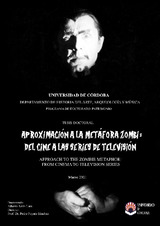Aproximación a la metáfora zombi: del cine a las series de televisión
Approach to the zombie metaphor: from cinema to televisión series
Autor
Añón-Lara, Alberto
Director/es
Poyato Sánchez, PedroEditor
Universidad de Córdoba, UCOPressFecha
2021Materia
ZombiesMuertos vivientes
Personajes cinematográficos
Películas de terror
Series de televisión
Filmografía
Metáfora zombi
Cine de terror
METS:
Mostrar el registro METSPREMIS:
Mostrar el registro PREMISMetadatos
Mostrar el registro completo del ítemResumen
Desde sus orígenes, el cine de terror y sus monstruos han sabido hablarnos de nuestros miedos y ansiedades sociales. Esta situación ha planteado numerosos interrogantes en torno hasta qué punto el género funciona como un reflejo de los principales acontecimientos históricos que han moldeado nuestra sociedad. Tomando esta idea como punto de partida, los espectadores encontrarían en figuras como el vampiro o el monstruo de Frankenstein, entre otros, una vía de escape a esas preocupaciones derivadas de las grandes crisis económicas y otros procesos sociales. Así, las diferentes formas de monstruosidad se erigirían como un receptáculo rebosante de significado metafórico que, en definitiva, es lo que ha llevado a muchos teóricos y críticos a estudiar las películas de terror desde un punto de vista sociológico. En este sentido, a pesar de su omnipresencia en las últimas décadas dentro de la cultura popular, el zombi ha pasado desapercibido a la hora de estudiar esa correspondencia entre lo que ocurre en la pantalla y la realidad social. Por este motivo, planteamos un estudio de la función metafórica de esta criatura desde sus orígenes cinematográficos hasta las actuales ficciones televisivas, tomando como referencia los momentos más determinantes de la historia del subgénero y prestando atención a las transformaciones que ha sufrido el personaje desde su primera aparición en la gran pantalla en 1932. Since its origins, horror films and their monsters have been able to speak to us of our fears and social anxieties. This situation has raised many questions about the extent to which the genre functions as a reflection of the major historical events that have shaped our society. Taking this idea as a starting point, viewers would find in figures such as the vampire or Frankenstein's monster, among others, an escape from those worries derived from the great economic crises and other social processes. Thus, the different forms of monstrosity would stand as a receptacle brimming with metaphorical meaning which, ultimately, is what has led many theorists and critics to study horror films from a sociological point of view. In this sense, despite its omnipresence in recent decades within popular culture, the zombie has gone unnoticed when it comes to studying the correspondence between what happens on the screen and social reality. For this reason, we propose a study of the metaphorical function of this creature from its cinematographic origins to current television fiction, taking as a reference the most decisive moments in the history of the subgenre and paying attention to the transformations that the character has undergone since its first appearance on the big screen in 1932.

